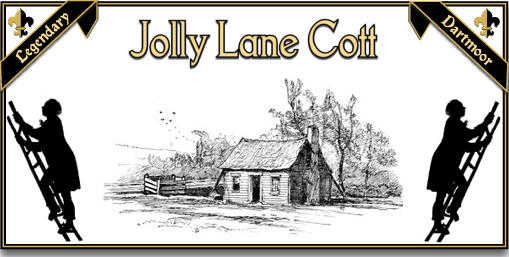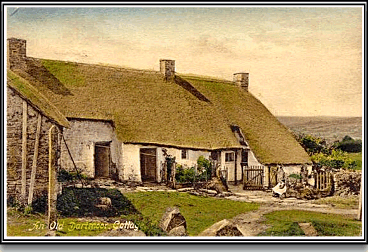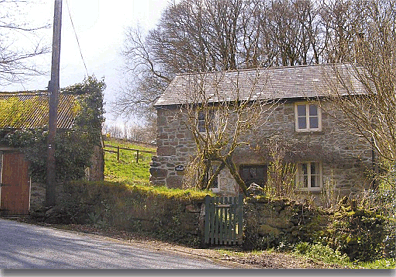
Visit the small village of Hexworthy and you will find a few houses, a pub, the only example of a Celtic style cross on Dartmoor and some splendid views. If you wander downhill from the pub you will see a small cottage on your left, which today seems nothing more than a quaint Dartmoor home. However its history is well and truly written in Dartmoor Legend because this was the last cottage ‘built in a day’ on Dartmoor.
Up to the early 1800’s there was a tradition on Dartmoor that if any man could build a house in a day and have a peat fire lit in the hearth by nightfall then the builder could claim ‘squatter’s rights’ and claim the house as his own. In 1835, Tom and Sally Satterley (or Satterleigh) needed a house for Sally’s father, Peter and her step mother, Ann to live in. Despite asking local landowners, who were most unhelpful they could find nothing suitable so they decided to participate in a spot of ‘land cribbing’. Having enlisted the help of many of their friends and neighbours they waited for a time when the local landowners would be absent and so unable to hinder their plans. Such an opportunity came on the day of the Holne Revel or Ram Roast (some writers say it was Ashburton Fair) when all the farmers would attend and as likely as not spend the day ‘making merry’. Having watched the small group of sturdy Devon yeoman leave for the revel the labourers set to work. Throughout that day the moorfolk toiled hard, no sooner had the walls at one end gone up, the thatch was being laid at the other end and by nightfall the cott was finished and a fire burning in the hearth. When the landowners returned they saw the house but knew there was very little they could do. There are two versions to the outcome of this case of ‘land cribbing’. Crossing 1987, p.24 considers that although not evicted, the Satterleys’ were charged a small rent by the Duchy of Cornwall. On the other hand, Woods, 2000 p.25 suggests that no action was taken by the farmers because of the fact the house was built for the elderly parents or because the land on which the house was built was agriculturally unproductive.
John and Ann Satterley spent the rest of their days in Jolly Cott and upon their deaths Sally and Tom moved in. Over the years they improved the homestead with many additions such as a garden, granite steps leading up to their ‘Acre field’, and leating a nearby stream into a dipping well which was built outside the cott gate.
After Tom died Sally remained at Jolly Cott and became somewhat of a legend in her own right. It was said that she could “doctor pigs and ponies and do almost anything a man could”. Wood, 2000 p.25 states that she could dig a ditch, lay a hedge, cut peat, mow with a scythe, shoe a horse, lead pack horses and even spear fish salmon. There is mention of her working at Eylesbarrow, one of the nearby tin mines. Sally was also in demand for her undertaking abilities, she would lay out the dead and often led funeral processions across the moor singing as she went. Not only required at ‘dispatches’ she used to attend ‘hatches’ and in her time delivered many babies. It was her boast “she never lost one”. She also had an extensive knowledge of Devon folksongs which led to a visit from Sabine Baring Gould who along with Dr. Bussell wrote down many of the songs. Judy Chard 1990, p.14, comments on how apparently she was unable to sing them outright and the two men had to follow her around as she did her chores and sang the songs. Some of Sally’s songs later appeared in Baring Gould’s book – Songs of the West One one occasion, whilst peeling potatoes she sang the ballad – ‘Lord Thomas and the Fair Eleanor‘, both Bussell and Baring Gould noted down the melody and the lyrics. Baring Gould 1982, p.201, recalls how Bussell was seated on the old washing copper under which Sally’s daughter lit a fire forcing him to find a cooler seat. Oddly enough this was one Devon ballad that did not appear in Baring Gould’s book:
Lord Thomas and the Fair Eleanor.
Lord Thomas he was a bold forester and the keeper of our Lord’s deer
Fair Eleanor being a young woman Lord Thomas, he loved her so dear
Lord Thomas he loved her so dear.
Come me riddle me, mother, Lord Thomas he said, come riddle me all at one,
Whether I shall have Fair Eleanor or bring the Brown Girl home
Or bring the Brown Girl home.
The Brown Girl she’s got riches and land, Fair Eleanor she’s got none,
And this I think to my blessing, bring me the Brown Girl home,
Bring me the Brown Girl home.
Lord Thomas he rode to Fair Eleanor’s bower and boldly the bell did ring,
There was none so willing as Fair Eleanor to let Lord Thomas in
To let Lord Thomas in.
What news? What news, Lord Thomas? she said. What news has thou brought me?
I have come to invite thee to my wedding, and that’s bad news for thee,
And that’s bad news for thee.
She dressed herself all in milk white, and her merry men all in green,
And every town that she went through, they took her to be some queen
They took her to be some queen.
Then she rode till she came to Lord Thomas’ bower and boldly the bell did ring,
There was none so willing as Lord Thomas to let Fair Eleanor in
To let Fair Eleanor in.
He caught hold of her lily-white hand and led her up the hall
He set her above his own bride above the gay ladies all
Above the gay ladies all.
Is this thy bride, Lord Thomas, she said, I’m sure she looks wondrous brown,
When thou could’st have had me, as fair a lady as ever trod foot to ground,
As ever trod toot to ground.
Despise her not, Lord Thomas he said, despise her not unto me
For better I love thy little finger than I do her whole body
Than I do her whole body.
The Brown Girl had a little penknife that cut both keen and sharp
And between Fair Eleanor’s long and short ribs she plunged it into her heart,
She plunged it into her heart.
Then off he cut his own bride’s head and dashed it against the wall:
He leaned his sword upon the ground and on the point did fall,
And on the point did fall.
Oh, dig me a grave, Lord Thomas he cried, both long and wide and deep,
And lay Fair Eleanor at my side and the Brown Girl at my feet
The Brown Girl at my feet.
Lord Thomas was buried beneath the church wall, Fair Eleanor in the choir,
Out of Fair Eleanor grew a red rose and out of Lord Thomas a briar,
Out of Lord Thomas a briar.
They grew and grew to the chancel top till they couldn’t grow any higher
And there they entwined in a true lovers’ knot for all the people to admire,
For all the people to admire.
The old postcard below shows Jolly Lane Cott, Sally Satterley is thought to be the lady to the left of the door.

The picture below shows Jolly Lane Cott in 2005, if you look closely you can just about see the brickwork of the original cott with a small piece jutting out on the left hand side.

It seems that Sally had the knack of being ‘the last’ for not only was she the last person to build a house in a day she was also the last person to have her coffin laid on ‘The Coffin Stone‘. She died in 1901 aged 87.
Bibliography.
Baring Gould, S. 1982 A Book of Dartmoor, Wildwood House, London
Chard, J. 1990 The House that Tom and Sally Built, Dartmoor Magazine No. 18, Quay Publishing, Brixham.
Crossing, W. 1987 One Hundred Years on Dartmoor, Devon Books, Exeter
Hemery, E. 1983 High Dartmoor, Hale Publishing, London.
Woods, S. 2000 Widecombe in the Moor, Halsgrove, Tiverton
 Legendary Dartmoor The many aspects past and present of Dartmoor
Legendary Dartmoor The many aspects past and present of Dartmoor

Where can I purchase a copy of this book my Nan is a satturley and has mentioned the book to me would love a copy
Hi, I’m not sure what book you are referring to? At the bottom of the webpage are a list of books from which the information was taken and all apart from the Dartmoor Magazine should be available from any bookshop or online retailer.
Ok thank you
I once stayed in this cottage with my new wife, my mother & father and younger brother over 35 years ago. While it conjures a very romantic image we found the cottage to be a bit damp, it may have been the time of year. While I don’t think anything paranormal occurred I found it to be a bit spooky.
We were only there for a week but had a good time.
It’s not damp now it’s been tanked. We had the roof re-slated last year, so should be good for another hundred years. It’s certainly not spooky, we’ve lived here for 12 years and it’s just home.
My great great grandmother built this!
Great item.
Past pictures?
Me and my partner are hoping to see this and the funeral stone today, Sarah and Thomas were his 3x great grandparents.